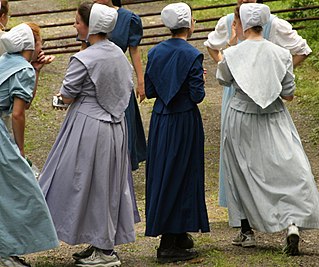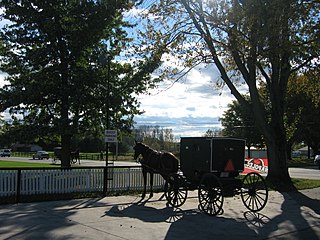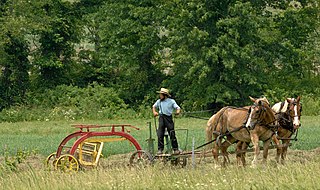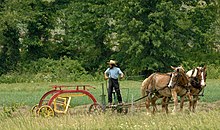
The Nebraska Amish, also called Old Schoolers, are a relatively small affiliation of the Amish. They are the most conservative subgroup of Amish, indicated not only by their use of technology but also by their particular style of dress. They emerged in 1881 as a conservative split from the Byler Amish, who themselves emerged as the first conservative splinter group from the Amish mainstream in 1849.

The Old Order River Brethren are a River Brethren denomination of Anabaptist Christianity with roots in the Radical Pietist movement. As their name indicates, they are Old Order Anabaptists.
Old Order Mennonites form a branch of the Mennonite tradition. Old Order are those Mennonite groups of Swiss German and south German heritage who practice a lifestyle without some elements of modern technology, still drive a horse and buggy rather than cars, wear very conservative and modest dress, and have retained the old forms of worship, baptism and communion.
The New Order Amish are a subgroup of Amish that split away from the Old Order Amish in the 1960s for a variety of reasons, which included a desire for "clean" youth courting standards, meaning they do not condone the practice of bundling during courtship. Tobacco and alcohol are also not allowed. They also wished to incorporate more evangelical elements into the church, including Sunday school and mission work. Some scholars see the group best characterized as a subgroup of the Old Order Amish, despite the name.
Donald B. Kraybill is an American author, lecturer, and educator on Anabaptist faiths and culture. Kraybill is widely recognized for his studies on Anabaptist groups and in particular the Amish. He has researched and written extensively on Anabaptist culture. He is Distinguished Professor Emeritus at Elizabethtown College and Senior Fellow Emeritus at Elizabethtown's Young Center for Anabaptist and Pietist Studies.
Amish Mennonites came into existence through reform movements among North American Amish mainly between 1862 and 1878. These Amish moved away from the old Amish traditions and drew near to the Mennonites, becoming Mennonites of Amish origin. Over the decades, most Amish Mennonites groups removed the word "Amish" from the name of their congregations or merged with Mennonite groups.

The Kishacoquillas Valley, known locally as both Kish Valley and Big Valley, is an enclosed anticlinal valley in the Ridge-and-valley Appalachians of Central Pennsylvania, and is located in Mifflin and Huntingdon counties.

The Groffdale Conference Mennonite Church, also called Wenger Mennonites, is the largest Old Order Mennonite group to use horse-drawn carriages for transportation. Along with the automobile, they reject many modern conveniences, while allowing electricity in their homes and steel-wheeled tractors to till the fields. Initially concentrated in eastern Lancaster County, Pennsylvania, their numbers had grown to 22,305 people resided in eight other states as of 2015. They share the pulpit with the Ontario Mennonite Conference but have some differences in Ordnung.

The Amish, formally the Old Order Amish, are a group of traditionalist Anabaptist Christian church fellowships with Swiss German and Alsatian origins. As they maintain a degree of separation from surrounding populations, and hold their faith in common, the Amish have been described by certain scholars as an ethnoreligious group, combining features of an ethnicity and a Christian denomination. The Amish are closely related to Old Order Mennonites and Conservative Mennonites—denominations that are also a part of Anabaptist Christianity. The Amish are known for simple living, plain dress, Christian pacifism, and slowness to adopt many conveniences of modern technology, with a view neither to interrupt family time, nor replace face-to-face conversations whenever possible, and a view to maintain self-sufficiency. The Amish value rural life, manual labor, humility and Gelassenheit.
The Swartzentruber Amish are the best-known and one of the largest and most conservative subgroups of Old Order Amish. The Swartzentruber Amish are considered a subgroup of the Old Order Amish, although they do not fellowship or intermarry with more liberal Old Order Amish. They speak Pennsylvania German as their mother tongue as well as English.
The Orthodox Mennonites, also called Wellesley Orthodox Mennonites and Huron Orthodox Mennonites, are two groups of traditional Old Order Mennonites in Canada and the US with about 650 baptized members. Even though plain to a very high degree and primitivist concerning technology, they are rather intentionalist minded than ultra traditional. Since 1999 they were joined by several other Old Order Mennonite communities.
Over the years, as Amish churches have divided many times over doctrinal disputes, subgroups have developed. The "Old Order Amish", a conservative faction that withdrew in the 1860s from fellowship with the wider body of Amish, are those that have most emphasized traditional practices and beliefs. There are many different subgroups of Amish with most belonging, in ascending order of conservatism, to the Beachy Amish, New Order, Old Order, or Swartzentruber Amish groups.

The Renno Amish, also called Beachy Amish or "black toppers" are a subgroup of Amish that was formed in 1863 in Mifflin County, Pennsylvania. They are the moderately conservative Old Order Amish group in Kishacoquillas Valley, locally called Big Valley, but still relatively conservative compared with the Amish of other regions.
The Noah Hoover Mennonites, called "Old Order Mennonite Church (Hoover)" by the Mennonite World Conference, and sometimes called "Scottsville Mennonites”, are a group of very plain Old Order Mennonites that originally came from the Stauffer Mennonites and later merged with several other groups. Today it is seen as an independent branch of Old Order Mennonites. The group differs from other Old Order Mennonites by having settlements outside the US and Canada and by attracting new members from other groups on a larger scale. They have more restrictions on modern technology than all other Old Order Mennonite groups. They are rather intentionalist minded than ultra traditional.
Stephen Scott was an American writer on Anabaptist subjects, especially on Old Order and Conservative Mennonite groups.
The John Dan Wenger Mennonites are an Anabaptist Christian denomination that belongs to the Old Order Mennonites. They use horse and buggy transportation and are mainly located in Virginia. Under the leadership of Bishop John Dan Wenger, they separated from the Virginia Old Order Mennonite Conference in either 1952 or 1953.
The Buchanan Amish affiliation is a subgroup of Amish that was formed in 1914 in Buchanan County, Iowa. It is among the most conservative in the entire Amish world. It is the fourth largest of all Amish affiliations, having almost as many church districts as the Holmes Old Order Amish affiliation. Geographically it is more dispersed than any other Amish affiliation.
A Seeker is a person likely to join an Old Order Anabaptist community, like the Amish, the Old Order Mennonites, the Hutterites, the Old Order Schwarzenau Brethren or the Old Order River Brethren. Among the 500,000 members of such communities in the United States there are only an estimated 1,200 to 1,300 outsiders who have joined them.

Old Order Anabaptism encompasses those groups which have preserved the old ways of Anabaptist Christian religion and lifestyle.

The Kauffman Amish Mennonites, also called Sleeping Preacher Churches or Tampico Amish Mennonite Churches, are a plain, car-driving branch of the Amish Mennonites whose tradition goes back to John D. Kauffman (1847–1913) and Noah Troyer (1831–1886) who preached while being in a state of trance and who were seen as "sleeping preachers".









